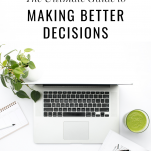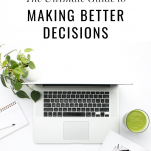Making better decisions requires better thinking, and this guide is here to help you in the process.
We make small decisions every day, like what to eat for breakfast and what to wear. Eliminating excessive options for these small decisions can lead to more ease and productivity in life, but that’s an entirely different post.
In this post, I consider a “big” decision to be anything that has a meaningful impact on the trajectory of your life. Some big decisions are expected, such as which school to choose, buying a house, or accepting a job offer.
Making Better Big Decisions
Some—if not many—situations will arise in your life where you need to make a big decision that you weren’t expecting or couldn’t predict. For me, getting divorced four years ago, moving to a new state, and deciding to change my business model to support my main business program all fall into this category.
I’m sure there will be more, and I know people are confronted with even more difficult situations every day.
While I’ve certainly made some not-so-great choices over the past few decades, one thing I’ve consistently done right has been to take my time and take a systematic approach to big decision-making.
It’s paid off big time.
I’m debt-free, own and run an industry-leading online business, have happy relationships, and feel pretty damn good about my sense of inner happiness and peace in life. I definitely don’t expect everything to look perfect or be perfect, but I know I have the tools and skillset to make good decisions as they come my way.
This guide aims to help you make better decisions, whether it’s in your relationships, career, starting your own business, or making a life-impacting change. I can’t make decisions for you—no one can, you have to learn to trust yourself—but this guide will assist you with whatever comes your way.
There are a few things you should do to prepare to use this as a guide for making any “big decision.”
Before You Begin:
- First, move your body for at least 20 minutes. Take a walk outside, go for a run, bike around the neighborhood, hit the gym, take a class, or find any way to move your physical body before doing this type of work. Exercise not only increases cognitive function, but it improves your mood. You’ll focus and think more clearly after 20-30 minutes of moderate exercise. And no need to overdo it—too much and you’ll wear yourself out. Don’t make big decisions right after you run a marathon or win a dance-off.
- Second, grab a pen and paper. It doesn’t have to be a fancy journal (though, those are nice if you have one) or even something that you plan on keeping. The most significant benefit of writing stuff down is that it clears the clutter in your head and gives you more space to think. You can write in any way that feels most comfortable to you: bullet points, paragraphs, lists, drawings, or whatever else feels right. Sometimes I use a whiteboard, sometimes a journal, and sometimes I just grab a piece of printer paper and get started. I gave you lists of journal prompts in this guide: you don’t have to do all of them, just use the ones that call to you and get the thoughts on paper.
- Third, trust that however the situation turns out, it will all work out in your favor. The future hasn’t happened yet—you get to create it. Even if something doesn’t turn out how you want, you can still make new and different decisions going forward.
The Ultimate Guide to Making Better Decisions
Step 1: Identify Your Highest Desire
First and foremost, before you make any decision, identify your Highest Desire.
Your Highest Desire could be the long-term vision for your life or a specific goal. It’s similar to your “why,” which is talked about extensively in the personal growth space. Your “why” is still important, but to me, your Highest Desire is even a level deeper.
What do you want to come out of making this decision? What are you trying to accomplish? It might be a more fulfilling career or relationship, more peace in your daily life, or more money in your bank account. Whatever it is, identify what you’re after before you make a big decision.
While it’s essential and necessary to identify what you want your life to look like when thinking about your highest desire, it’s often more productive to write out WHO do I want to BE.
For example, if you’re making a big decision about a relationship, think about who you want to be in your relationships instead of what you want the other person to change into (more on what you can and cannot control in a minute.)
Another example would be if you’re thinking about making a career change or starting a business, think about who you want to become. This might be wanting to become an industry thought leader, a person who openly shares what she learns so others can create success or someone who genuinely wants to see other people succeed. (BTW, all of those are high on my personal list!)
Journal Prompts:
- What do you want your daily life to look like?
- What are the three things you value most in life?
- How do you want to feel?
- What would make you feel most supported right now?
- What kind of person do I want to be?
- Once you know your Highest Desire and who you want to be, which of the options in front of you is in alignment with those things?
Step 2: Explore Your Biases
Something critical in the decision-making process is understanding the cognitive behavior of biases—simply put, the way your biases will affect your ability to think through your decision. There are many different types of biases, but in this context, the two you should consider are your confirmation bias and sunk cost bias.
Confirmation Bias:
Confirmation bias is the (usually subconscious) behavior of favoring information that confirms a pre-existing belief. It’s the tendency to interpret new evidence as confirmation of one’s existing beliefs or assumptions.
For example, if you’re thinking about starting a business or changing careers, but you have a self-limiting belief that you can’t be successful, your subconscious mind will interpret facts to confirm this belief. Let’s say you have the chance to learn with an industry leader, and you’re thinking about taking the training, but your mind says, “you can’t have a business like hers because you didn’t start early enough.” That’s your mind confirming your pre-existing belief, even though it’s not true.
Sunk Cost Bias:
Another bias that really sets people and companies on the wrong path is the sunk cost bias. A sunk cost bias is your tendency to continue to invest in or work on something because you’ve already spent time and resources on it. While being committed is an essential part of success, hanging on solely because you’re already invested in or worked on something prevents you from reaching your true potential.
I see this almost daily, from a person demanding more therapy and work from an intimate relationship to large companies holding onto products that just aren’t working. Sunk costs are OK. Holding onto them is not.
To avoid these biases, remember to think big picture, consider facts, and be willing to examine your belief systems.
Also, remember that you rarely have the full picture when making a big decision, and that’s OK. You don’t know as much as you think you do. There are always things you’ll be blind to, but do your best with the information that you do have.
Step 3: Get Clear What You Can and Cannot Control
Make big decisions based on what you can control, not on what you can’t control.
You can control your own actions and efforts. You can never control the actions and efforts of other people involved.
Relationship-wise, this means that you can control what you are willing to accept and not accept in a relationship, but you cannot control your partner’s actions. For example, if you find yourself saying “I will stay and be happy if this person [insert action such as “does not cheat,” “is more responsible with money,” etc.],” try to shift the thought to “Can I be happy and content if I accept this situation exactly the way it is?” Remember, you can control your actions, but not the actions of others. Don’t make big decisions betting on whether or not someone will commit to a considerable change.
From a business perspective, you can control how you invest in yourself and the effort you put into your growth. You cannot control external factors, such as whether or not your family and friends applaud your decision or what other people think of you.
Step 4: Futurecast Using the 1x1x1x1 Model
Futurecasting is a strategy businesses use to model the future to make better decisions in the present. One way you can use this tool in your personal life is to think about the impact of a decision in 1 week, 1 month, 1 year, and 1 decade. I call this the 1x1x1x1 Model.
If your life isn’t impacted in 1 week, 1 month, 1 year or 1 decade, then this really isn’t a big decision. But if you’re going to enter into a longterm relationship, start a new business (or stay in your current career), this model can help you gain clarity and choose the right path.
Journal Prompts:
- How will this decision affect my life in 1 week?
- In 1 month?
- In 1 year?
- In 1 decade?
- Which option gives me the life I want on each of these timelines?
Step 5: Identify Both the Worst-Case & Best-Case Scenarios
By now, you’re leaning one way or the other.
Another useful tool is to write out both the worst-case and best-case scenarios.
Write out the worst-case scenario first. The reason you should do this first is that it’s never as bad as you think. For real! Let’s say you start a business, and it doesn’t turn out how you want. While it’s not ideal, you know what? At least you did something. You’ll learn from it, and you can start something else or find meaningful work in your field. It’s never as bad as you think it will be. Or, maybe something happens and you’ll feel embarrassed. Still, you did something, and no one doing great things will EVER judge you. Every action you take will lead to improvement, regardless of what the result produces.
After you do that, it’s time to write out the best-case scenario. This is where the magic begins! You’re starting to form a vision for your future, and visioning exercises WORK. What you tell yourself is what you will begin to believe. Write out the best-case scenario on a separate note card or piece of paper and use it to inspire your action.
Journal Prompts:
- What’s the worst-case scenario?
- What’s the best-case scenario?
Step 6: Consider the Opposite or Alternative
Now that you’re leaning towards a decision, consider the opposite or alternative. This generally can be the final push you need to take action, or go back to the beginning and examine all of your options.
Here’s an example:
You’re leaning towards the decision to start a blog or online business because your Highest Desire (from Step 1) is 1) to be in control of your time and finances, 2) you don’t want to rely on someone else for work, and 3) you want to share the knowledge you have on a particular topic because you know it will leave people better off than before they found you. What’s the alternative? Staying comfortable in a job or career you feel lackluster about, and keeping all of your knowledge and information to yourself? If the alternative doesn’t feel as good as what you want, then you know you’re on the right path.
This step can also include a cost-benefit analysis of what you may gain or lose when making this decision.
Journal Prompt:
- What’s the alternative to the decision (or solution) I’m leaning towards?
- What are the costs vs benefits of this decision?
- What are you willing to give up to gain what you want? This often includes giving up some level of clarity or certainty in the short term to gain what you want in the long term.
Step 7: Check External Filters, Voices & Opinions
Other people will have their own beliefs and truths, but they do not have to be yours. It can be great to hear other people’s perspectives, but you don’t have to agree with them as your truth.
When someone’s giving you advice (solicited or not), they can only see life through the filter of their own life experiences. Sometimes this can be useful, but don’t let it cloud your decision-making process.
Here’s an example: recently, a friend of mine told me that when he was considering divorce, his friend said, “You can’t get divorced—another man will raise your kids.” Not only would that be difficult for anyone to hear, if my friend didn’t filter this out, he may have accepted that it was true. However, it’s NOT true. He knew the difference between someone else’s filter and truth. My friend knew that he would still have a great relationship with his kids (and he does), and he would be the main man in their lives (and he is). His friend had a lot of conviction in his statement, but it wasn’t my friend’s truth.
Step 8: Trust Yourself
I can’t reiterate this enough; you have to trust yourself.
Trusting yourself is not about being perfect; no human is perfect, and no human makes perfect decisions. Trust isn’t about making the perfect decisions. Trust comes from knowing that whatever happens, you can make a new decision if or when one is needed. You’ll continue to gain new experiences, new knowledge, and fresh insight into what you want, and you’ll be completely prepared to make your next decision.
Step 9: Give Yourself a Reasonable Timeline to Decide
Not too fast. Not too slow.
Don’t act in haste, but also remember that in putting off a decision, the decision is often made for you.
I can’t stress this enough—I have NEVER regretted waiting 24 hours to respond to anything or making a decision, but I have regretted acting too soon. I have a general rule that I always wait 24 hours before responding to new requests or anything that requires even a semi-important decision.
The opposite is also true. When confronted with a big decision, give yourself a deadline. There isn’t a set guideline for this; it really depends on the person or situation. Just remember that a lack of deciding is pretty much deciding in and of itself. If you don’t decide, someone or something else could decide for you. A day, a week, or a month, just give yourself a timeline.
Step 10: Create an Environment to Flourish
Now the fun begins. This one isn’t so much part of the decision-making process, but more of what to do next. Now that you’ve made your decision and you’re ready to go, the next important step is to create both physical and mental environments to flourish. What do you need to change, move, or rearrange in your life to help make your decision flourish? Your environment influences how you feel, think, and act; be sure to create it with intention.
What Do You Think?
Did this guide help you? Share any insights or thoughts with other readers in the comments below to inspire positive change in others.
Cheers!









I love this 🙂 it has helped a lot – the best and worst case scenario part most helped me!!! Completed the exercise and it was really amazing xxx